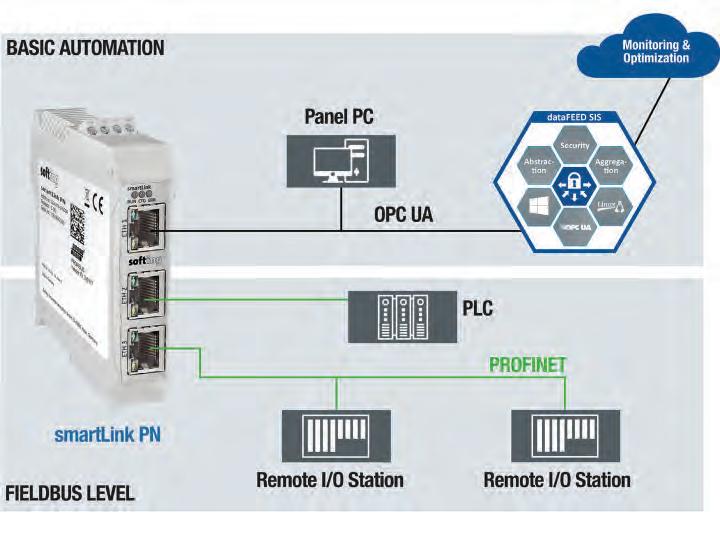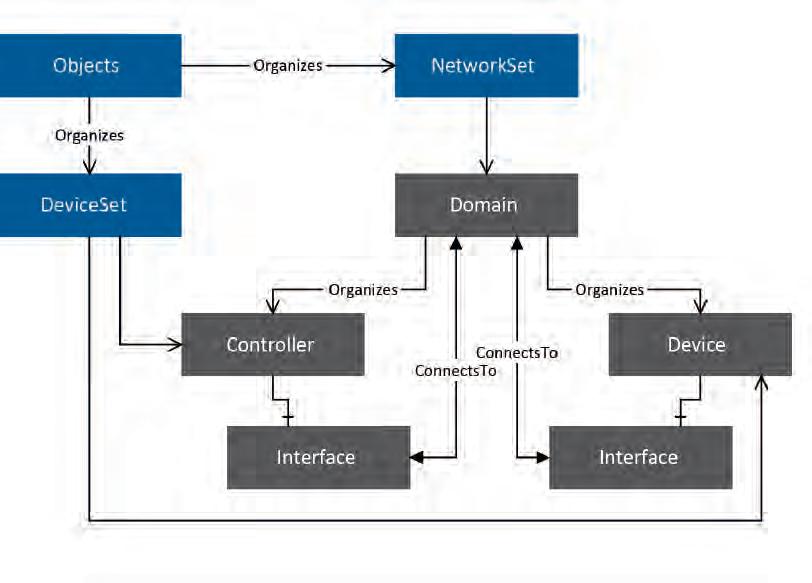
6 minute read
Smart devices leverage PROFINET and OPC UA
Smart devices provide operators not only with I/O data but also with a wealth of information about industrial plant operation. Information collected from field devices such as diagnostic data, status information on devices and specific device parameters can also help plan predictive maintenance programs.
SMART DEVICES IN MODERN PRODUCTION environments and processing plants provide operators not only with I/O data but also with a wealth of information about the state of the entire plant. The information that management systems are able to collect from these field devices, such as diagnostic data, for example, status information on the devices and specific device parameters, can help the organization plan its predictive maintenance program.
This information helps to prevent unplanned stoppages, reduces downtime and lowers maintenance costs. To enable plant operators to make the most of this potential for process optimization and cost reduction, the data delivered by all the installed devices must be transparent and, most importantly, standardized.
Use case network monitoring
As networks continue to expand, more and more additional TCP/IP communication is taking place in parallel with PROFINET communication. Continuous information about the current state of the network, the communication processes within the network, and their quality is therefore becoming increasingly important.
In the IT market there are already sophisticated monitoring systems for this purpose that are continuously managed by administrators. But network monitoring systems are also finding their way into the automation environment. High network availability is just as important in OT as in IT. Unplanned downtimes caused by non-compliant functions can lead to production stoppages and, in a worst-case scenario, damage to the system. This can result in huge costs and lost profits.
If the automation network is continuously monitored, however, errors can be detected at an early stage and resolved before they have a chance to do any damage. With serial bus systems like PROFIBUS, the main focus is on bus physics, e.g. the quality of cables, circuits and connectors. In Ethernet systems, including PROFINET, the physical structure is unlikely to contribute to downtime. In fact, the growing complexity of devices and networks requires the qualitative assessment of a large number of parameters at a logical
Sample application for smartLink PN.
level. Nowadays, modern network diagnostics means obtaining as much information as possible from active requests by participants and from the analysis of frame traffic. There are basically two use cases:
Asset management
Certified PROFINET devices provide a variety of information about themselves, about the configuration of modules and submodules, and about adjacent devices. This data enables a complete picture of the assembled system to be generated. By cyclically querying this data, all changes, such as firmware updates, swapping switch ports or changing modules, can be precisely logged.
Diagnosis
Certified PROFINET devices provide detailed status information about the devices themselves and about the sensors and actuators to which they are connected. They record all faults, such as connection breakdowns or malfunctions, as well as statistical variables in the network such as frame repetition and increased jitter. This information is sent to the controller and stored in a device-specific database which can then be queried.
Common goal, no common standard
Because more and more manufacturing companies are starting to recognize the significant benefits offered by smart plant monitoring, requirement specifications of new plants increasingly often also include the necessary tools. This trend has helped the various providers of network monitoring and diagnostics systems to establish themselves on the market. Most of the systems on offer take the form of an additional device that is connected to the network and collects diagnostic and asset data. The data is clearly displayed on a variety of dashboards via an integrated webserver. Since PROFINET defines the framework within which the data is made available, the functional differences between the tools are relatively small.
The other common characteristic relates to the transfer of collected data to higherlevel IT systems: it is simply not possible. Although the values are always the same and are displayed similarly, there is no standard enabling the non-proprietary exchange of data. This is where OPC UA comes in.
The OPC UA companion specification In June 2017, the PNO established the "OPC UA I4.0@PI” working group. The aim

was to create a "Joint OPC UA Companion Specification" for mapping PROFINET to OPC UA. The "OPC 30140 - UA Companion Specification for PROFINET" has SOURCE: SOFTING been under review since July 2019 and will probably be released in December 2019.
This first version of the specification focuses on use cases in the areas of asset management and diagnostics. An OPC UA server that implements the specification can run on a controller, edge gateway or IO device.
The OPC UA information model contains two views of a PROFINET network: the controller/application view and the device view. The controller/application view contains the PROFINET connections (application relations), the modules and submodules configured in the PROFINET controller. The device view consists of the PROFINET devices and their physically available modules and submodules. The OPC UA information model contains two views of a PROFINET network. Both views are linked via OPC UA references. Depending on where the OPC UA via references. Devices are contained in the "DeviceSet". The server is running, only parts of the views are The OPC UA information model is based on "NetworkSet" contains the PROFINET domains. available. An edge gateway provides both OPC UA specification V1.04 and uses OPC UA views of the PROFINET network. V1.04 Amendment 7 "Interfaces and AddIns". Implementing the specification
The information model also contains a map A useful annex to the specification Softing will provide the smartLink PN, an edge of the PROFINET network’s physical topology. provides an excellent description of how to gateway that collects data from PROFINET The OPC UA information model therefore use the information model with the "OPC networks and makes it available via OPC UA in contains precise details PROFINET devices’ UA Part 100 - Devices" V1.02 specification. accordance with the companion specification. wiring, their Ethernet interfaces, ports and A server offers entry points to the PROFINET The smartLink PN will have two 100 Mbit cables, all of which can be used for network OPC UA information model via the standard PROFINET switch ports, which allow asset and diagnostics. The submodules that provide the objects "DeviceSet" and "NetworkSet". diagnostic data to be established via both PROFINET interface and ports are connected The PROFINET Controller and PROFINET IO active requests and passive frame analysis. As a result, the entire spectrum of available information defined by the SOURCE: SOFTING companion specification is covered by a single device. The data collected will be supplied via a Gigabit interface that is separate from the automation network. It will be possible to connect smartLink PN to a system without interfering with normal operations. When used with Softing's dataFEED Secure Integration Server, which provides external applications with unilateral access to the data, PROFINET diagnostic and asset data can be exported securely and transparently to any system both inside and outside the company's own network.

Thomas Rummel, Senior Vice President Engineering & Product Management and Thomas Schwarzenböck, Product Manager, Softing Industrial










